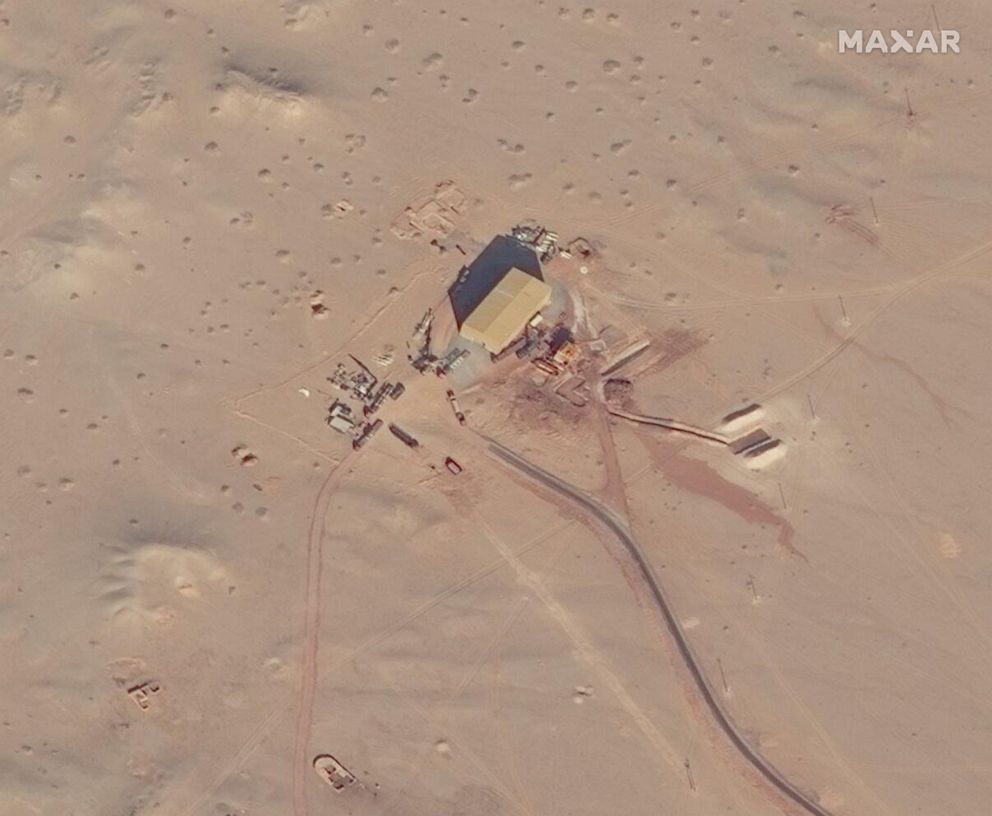根据五角大楼周三发布的一份新报告,中国正在迅速扩大其核武库规模,到2030年可能拥有多达1000枚核弹头。
此前,中国最近对一种高超音速武器进行了测试,这引发了人们对中国军事建设及其日益增长的能力的严重担忧。

卫星图像2021 Maxar技术
2019年11月18日,中国吉兰台疑似导弹发射井建设。
“中国不断加快的核扩张步伐可能会使中国(中华人民共和国)在2027年拥有多达700枚可交付核弹头,”今年版本的五角大楼年度报告称,该报告正式称为“涉及中华人民共和国的军事和安全发展。”
“中国可能打算到2030年拥有至少1000枚弹头,超过国防部在2020年预测的速度和规模,”它补充说。这一增长与去年版本报告中的预测大相径庭,该报告预测中国现有数百枚核弹头的核武库将翻一番。
即使中国大幅增加,其更大的核武库仍将远低于美国申报的3750枚弹头的库存,这些弹头可由数百枚陆基和海上发射导弹以及一个战略轰炸机群部署。

卢卡斯·席夫雷斯/盖蒂影像公司
中国国旗。
最近几个月,中国核力量的增长被商业卫星图像捕捉到,这些图像显示,在中国北部和西部的三个地点建造了数百个导弹发射井。
该报告称:“2020年的新发展进一步表明,中国打算提高其核力量在和平时期的战备状态,转向预警发射(LOW)态势,扩大发射井基础力量。
中国领导人公开表示,他们希望中国军队在2050年成为全球强国,因为他们超越了目前被评估为只具备地区能力的军事力量。
该报告指出,中国军事能力的增长与该计划相一致,指出它们“继续加强中国对“强大敌人”(这可能是美国的委婉说法)进行“打胜仗”的能力,在领土争端中胁迫台湾和竞争对手,对抗第三方对中国周边冲突的干预,并在全球投射力量。”
这种日益增长的军事能力最近得到了证明,此前有报道称,今年夏天,中国测试了一种新型高超音速滑翔武器,能够绕地球飞行,最终可能携带核武器。
“分数轨道轰击系统”的发展引起了人们的担忧,即美国如何应对这种系统,这种系统可以想象在重返大气层后以高超音速飞行,或超过音速的五倍。
像其他高超音速飞行器一样,很难跟踪,因为滑翔飞行器在大气层中具有机动性,不像弹道弹头那样遵循固定的轨迹,这意味着它们可以绕过美国雷达和陆基拦截导弹系统。
“美国目前甚至没有能力跟踪这种武器,更不用说击败它了,”退役海军上校、美国广播公司新闻撰稿人史蒂夫·甘亚德(Steve Ganyard)说,他指出,美国雷达指向北极上空导弹的冷战威胁,无法探测到来自南方的高超音速武器。
周三早些时候,美国参谋长联席会议主席马克·米利(Mark Milley)将军承认,中国最近对一种显然能够运载核弹头的高超音速武器的测试“非常重要”,但“不是人造卫星时刻”,至少在新颖性方面是如此。
这个词指的是1957年苏联发射的人造卫星,它让美国人措手不及,导致美国奋起直追,导致太空和军备竞赛。
“它们不是新的,它们已经存在了一段时间。所以,在这个有限的、狭义的意义上,这不是一个人造卫星的时刻,因为人造卫星在当时是新的,”米莉在华盛顿特区的阿斯彭安全论坛上评论说
上周,米莉是第一个公开确认测试的美国官员,称其为“一个非常重大的技术事件”,但他也表示,他不知道“这是否是一个相当大的人造卫星时刻,但我认为它非常接近那个时刻。”
米莉将这次测试描述为中国在国际舞台上扮演更重要角色的大趋势的一部分。
“如果你从总体上来看,几周前发生的这次试验只是中国军事能力的一个更广泛的图景之一,”米莉说。“这非常非常有意义。在我看来,我们正在见证全球地缘战略力量的一次最大转变。”
台湾附近最近的飞行活动再次引发了人们的担忧,即中国是否准备对这个它认为是一个分裂省份的岛屿发动军事行动。
当被问及他是否认为中国可能入侵台湾时,米莉回答说,“根据我对中国的分析,我认为这不太可能在不久的将来发生,”他将这段时间定义为未来6到24个月的时间。
“话虽如此,但中国正在明确无误地建立能力,向国家领导层提供这些选择,如果他们在未来某个时候选择这样做的话,”他说。
China could have 1,000 nuclear warheads by 2030: Pentagon
China is rapidly increasing the size of its nuclear arsenal and could have as many as 1,000 nuclear warheads by 2030, according to a new Pentagon report released Wednesday.
The development comes on the heels of China's recent test of a hypersonic weapon that has raised serious concerns about China's military buildup and its growing capability.
"The accelerating pace of the PRC’s nuclear expansion may enable the PRC (People's Republic of China) to have up to 700 deliverable nuclear warheads by 2027," said this year's version of the annual Pentagon report formally known as "Military and Security Developments Involving the People’s Republic of China."
"The PRC likely intends to have at least 1,000 warheads by 2030, exceeding the pace and size the DoD projected in 2020," it added. That increase is dramatically different than was projected in last year's version of the report which predicted a doubling of China's current nuclear arsenal of several hundred warheads.
Even with China's dramatic increase, it's larger nuclear arsenal will still be much less than the United States' declared stockpile of 3,750 warheads capable of being deployed by hundreds of land-based and sea-launched missiles and a strategic bomber fleet.
In recent months, the growth of China's nuclear force has been captured by commercial satellite images showing the construction of hundreds of missile silos at three locations in northern and western China.
"New developments in 2020 further suggest that the PRC intends to increase the peacetime readiness of its nuclear forces by moving to a launch-on-warning (LOW) posture with an expanded silo-based force," said the report.
China's leaders have publicly stated that they want China's military become a global power by 2050 as they move beyond what is currently assessed to be a military force with only regional capabilities.
The report indicated China's growth of its military capabilities are in line with that plan noting that they "continue to strengthen the PRC’s ability to “fight and win wars” against a “strong enemy" [a likely euphemism for the United States], coerce Taiwan and rival claimants in territorial disputes, counter an intervention by a third party in a conflict along the PRC’s periphery, and project power globally.”
That growing military capability was demonstrated recently after reports emerged that over the summer China had tested a new hypersonic glide weapon capable of orbiting the earth that could eventually carry a nuclear weapon.
The development of a "fractional orbital bombardment system" raised concerns about how the United States could counter such a system that could conceivably travel at hypersonic speeds, or greater than five times the speed of sound, after reentering the atmosphere.
Like other hypersonic vehicles it would be hard to track because the glide vehicles are maneuverable in the atmosphere, unlike ballistic warheads that follow a fixed trajectory, meaning they could weave their way around American radars and ground-based interceptor missile systems.
"The U.S. does not currently have the ability to even track this weapon, much less defeat it," said Steve Ganyard, a retired Marine colonel and ABC News contributor who noted that American radars pointing to the Cold War threat of missiles coming over the North Pole would not be in a position to detect a hypersonic weapon coming from the south.
Earlier on Wednesday, Gen. Mark Milley, the chairman of the Joint Chiefs of Staff, acknowledged that China's recent test of an apparent hypersonic weapon capable of delivering a nuclear warhead was "very significant," but "not a Sputnik moment," at least in terms of novelty.
That term refers to the 1957 launch of the Sputnik satellite by the Soviet Union that caught Americans off guard and led the United States to play catch up leading to a space and arms race.
"They're not new, they've been around for a while. So, in that limited, narrow sense, it's not a Sputnik moment, because Sputnik was new at the time," Milley said in comments at the Aspen Security Forum in Washington, D.C.
Last week, Milley was the first American official to publicly confirm the test labeling it "a very significant technological event" but also said he didn't know "if it's quite a Sputnik moment, but I think it's very close to that."
Milley described the test as part of the larger trend by China to be a bigger player on the international stage.
"If you look at the totality, this test that occurred a couple weeks ago is only one of a much, much broader picture of a military capability with respect to the Chinese," said Milley. "That is very, very significant. We're witnessing, in my view, we're witnessing one of the largest shifts in global geostrategic power at the world has witnessed."
Recent flight activity near Taiwan has once again raised concerns about whether China is poising to launch military action against the island it considers to be a breakaway province.
Asked if he believed that China is likely to invade Taiwan, Milley replied, "Based on my analysis of China, I don't think that is likely in the next near future," a time period he defined as meaning over the next six to 24 months.
"Having said that, though, the Chinese are clearly and unambiguously building the capability to provide those options to the national leadership if they so choose at some point in the future," he said.






